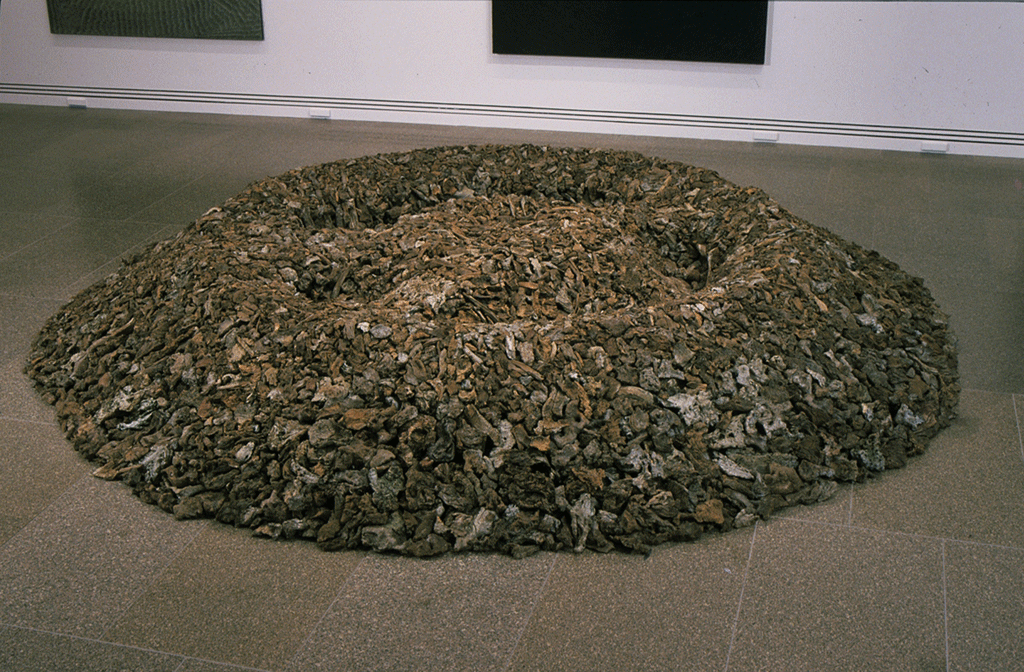Malleefowl nest 6: Spring, 2000
Chemistry: South Australian Art 1900 – 2000
Art Gallery of South Australia, Adelaide, Australia
James Darling & Lesley Forwood, Malleefowl nest 6: Spring, 2000, Mallee roots, at Chemistry: South Australian Art 1900 – 2000, Art Gallery of South Australia
“…Now, in evidence of this, the Gallery’s Curator of Australian Art, Sarah Thomas, has put together a show which details a decade of advanced practice in the state. Names such as Fiona Hall and Hossein Valamanesh, and Ian Abdulla, Annette Bezor, these are pretty well known beyond the South Australian borders; others are only beginning to make their mark nationally - Deborah Paauwe, Shaun Kirby, Zhong Chen, Craige Andrae, et cetera; and a few, Anthony Hamilton and Ann Newmarch particularly come to mind, have national reputations, but with a specifically almost achingly Adelaidian emphasis. And then there’s James Darling. His accurately recreated mallee fowl nest is an installation to challenge all one’s tidies precepts about art, wherever is be. It’s a real showstopper…”
Arts Today reviews “Chemistry” Radio National, Compere Michael Cathcart with Bruce James
“… wide-ranging survey exhibitions present an embarrassment of complexities for reviewers and so it is with Chemistry. One complications is that by the mid 90s installation art was a dominant expression, yet painting and formal sculpture still held their own. Just how powerful installation art was and is can be seen in two resonating works, George Popperwell’s Region (1994-96) and James Darling’s Malleefowl nest: Spring (2000).
Popperwell’s plywood constructions and wall elements take up a whole gallery and allude to the Holocaust, the architecture of Auschwitz and the colouor-coded symbols worn by the various inmate groupings of Nazi concentration camps. It’s a bleak, unsettling work whose unadorned timber constructions are drained of colour as if of life.
Region is thus a meditation on the chemistry of man’s inhumanity to man. James Darling’s work is no less sombre but it is located in the present and the degrading chemistry we have brought to the natural environment. Due to land clearance, salinisation and feral predation, the gentle mallee fowl is one of Australia’s most endangered species, Darling’s Malleefowl nest: Spring - high, rounded, poetically sculptural - is made of compacted mallee roots from his farming property near the Coorong. Ephemeral and fragile, its life span is merely that of the exhibitions and tells the viewer the emblematic creature is memorialises faces similar oblivion…”
“Creativity keeps a chemical balance”, by Peter Ward, The Australian, page 13, October 10, 2000
Notes to Malleefowl nest 6: Spring
A unique bird, the malleefowl (Leipora Ocellata), whose ingenious annual cycle of survival includes the precise harnessing of solar energy to incubate eggs deep in a mound, provides inspiration for the installation works of SA artist, farmer and conservationist, James Darling.
The only mound-building bird in arid land in the world, malleefowl inhabit the sparse, dry, variable mallee gum landscapes of southern Australia, (southern NSW, northern VIC, parts of SA & WA). Some of these wonderfully acute and industrious birds live in grey sand and mallee scrubland of the artist’s property.
Malleefowl nest 6: Spring enacts a precise moment in the ever-changing annual architecture of one particular malleefowl nest as the artist observed it the day before (5/9/00) he began to build in the art Gallery of South Australia.
In the bush, malleefowl mounds are made largely of sand raked up by the bird’s powerful feet into an immaculate circle. A pair of birds may spend up to 11 months of the year preparing and maintaining the mound with an exquisite artistry which adapts to daily, as well as seasonal, variations in temperature and rainfall. The labour is to establish 33C - exact and constant and measured by their heat-sensitive beaks - deep in the central egg laying chamber.
When 33 C is established and eggs can be laid, the mound becomes an incubating oven relying initially on composting fermentation. Its shape continues to change as the season warms. In summer the mound is heaped up like a pointed cone and the incubation process is dependent on solar energy alone.
Weathered and conserved mallee roots - the dens, knotted, spiky roots of the mallee gum tree (E.dumosa, E.diversifolia and hybrids) make unusual and pertinent artistic material. While the nest gains its structural strength from their random interlocking shapes, mallee roots resonate with fire, with decades of land clearing, in pioneer settlement structures and through the dry stone walls of other continents.
Malleefowl nest 6: Spring draws together disparate elements, the architectural perspicacity of the mallefowl, intrinsically appropriate materials, a circle, a life-cycle - to give authority to a single reverberating sculptural image.


